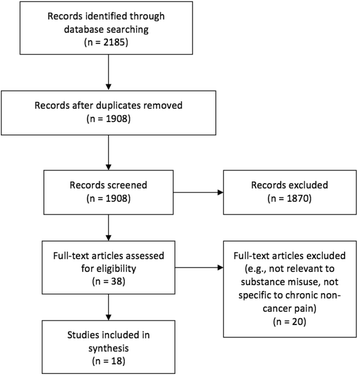Chronic pain and opioid misuse: a review of reviews
- PMID: 28810899
- PMCID: PMC5558770
- DOI: 10.1186/s13011-017-0120-7
Chronic pain and opioid misuse: a review of reviews
Abstract
Objective: The crisis of prescription opioid (PO) related harms has focused attention toward identifying and treating high-risk populations. This review aims to synthesize systematic reviews on the epidemiology and clinical management of comorbid chronic pain and PO or other substance misuse.
Methods: A systematic database search was conducted to identify systematic reviews published between 2000 and 2016. Eligible studies were systematic reviews related to chronic non-cancer pain and PO or other substance misuse. Evidence from the included reviews was synthesized according to epidemiology and clinical management themes.
Results: Of 1908 identified articles, 18 systematic reviews were eligible for final inclusion. Two meta-analyses estimated the prevalence of chronic non-cancer pain in individuals using POs non-medically to be approximately 48% to 60%, which is substantially higher than the prevalence of chronic non-cancer pain in general population samples (11% to 19%). Five systematic reviews estimated the rates of PO or other opioid use in chronic pain populations with substantial variation in results (0.05% to 81%), likely due to widely varying definitions of dependence, substance use disorder, misuse, addiction, and abuse. Several clinical assessment and treatment approaches were identified, including: standardized assessment instruments; urine drug testing; medication counts; prescription drug monitoring programs; blood level monitoring; treatment agreements; opioid selection; dosing and dispensing strategies; and opioid agonist treatment. However, the reviews commonly noted serious limitations, inconsistencies, and imprecision of studies, and a lack of evidence on effectiveness or clinical utility for the majority of these strategies.
Conclusion: Overall, current systematic reviews have found a lack of high-quality evidence or consistent findings on the prevalence, risk factors, and optimal clinical assessment and treatment approaches related to concurrent chronic pain and substance misuse. Given the role of systematic reviews in guiding evidence-based medicine and health policy, there is an urgent need for high-quality primary research to guide future systematic reviews to address the escalating epidemic of harms related to chronic pain and substance misuse.
Keywords: Addiction; Chronic pain; Prescription opioid; Substance use; Systematic review (3–10 keywords required).
Conflict of interest statement
Ethics approval and consent to participate
Not applicable.
Consent for publication
All authors have consented the current manuscript for publication.
Competing interests
The authors have no competing interests to declare.
Publisher’s Note
Springer Nature remains neutral with regard to jurisdictional claims in published maps and institutional affiliations.
Figures
References
Publication types
MeSH terms
Substances
Grants and funding
LinkOut - more resources
Full Text Sources
Other Literature Sources
Medical


